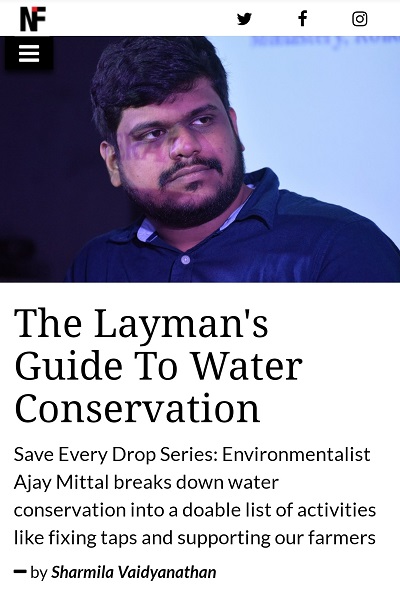Environmentalist Ajay Mittal breaks down water conservation into a doable list of activities like fixing taps and supporting our farmers.
As published in Nature inFocus on Tuesday, 30 June, 2020
My interview with Kolkata-based Ajay Mittal was scheduled for a Monday afternoon. This was days after his city had been ravaged by Cyclone Amphan. The phone rang only twice to be answered by a very apologetic Mittal. He was in the middle of a replantation drive where his volunteer organisations – Active Citizens Together For Sustainability (ACTS) and Kolkata Clean Air were treating and replanting trees uprooted by the storm to help salvage some of the damage. He wanted to reschedule the call for the next day.
For most of us, something like this would be a one-time volunteer effort, but for Mittal, it is a typical day at work. When he is not addressing the damage left behind by a cyclone, he is questioning authorities on Twitter about their response to the ongoing pandemic, emphasising the need for safety measures and distributing personal protective equipment to the public. In a pandemic and cyclone-less world, people will find him campaigning for clean air, talking about climate-related issues, organising blood donation drives and saving water – or as Mittal sums it up – Donate Red, Spread Green and Save Blue.
Last year, along with his friend and fellow ACTS volunteer Vijay Agarwal, Mittal initiated the ‘Fix For Life’ mission, which aims to fix leaking taps on the streets of Kolkata. The duo’s water conservation drives have gained them national and international recognition, and they were also featured in the Ministry of Jal Shakti, Department of Water Resources’ monthly magazine, Jal Charcha. Mittal is recognised as an environmental leader by the North American Association for Environmental Education – EE 30 under 30 (2019), and has been trained as a Climate Reality Leader in Brisbane, Australia, as part of the Climate Reality Project.
In this interview, the young environmentalist shares his thoughts about the water crisis and asserts that small steps can make all the difference when it comes to conserving the precious resource.
Read the complete interview here.
Cover image: Screenshot from https://www.natureinfocus.in/
